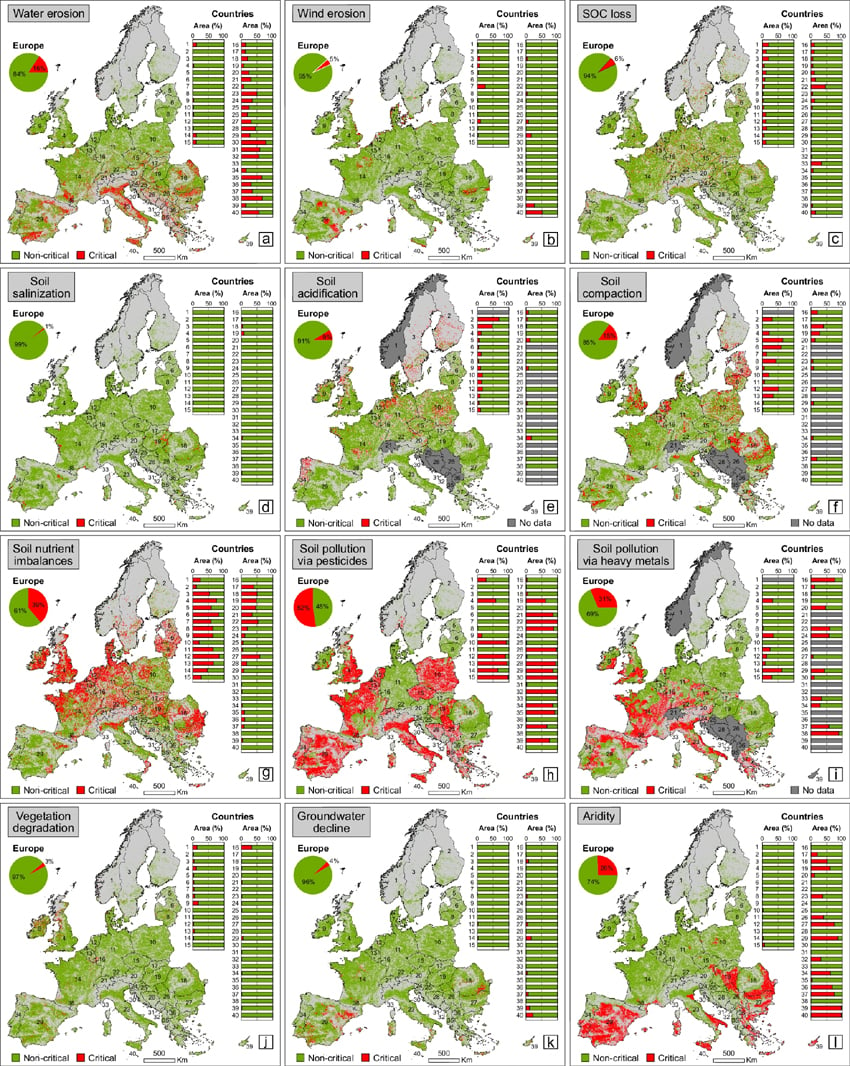European soils are degraded, compacted and contain worrying amounts of pesticides according to research published in Nature Communications.
A group of 16 researchers from Romania, Switzerland, Italy, UK, Spain, Australia and China analysed multiple land degradation pathways across the European continent. They recorded a mixed picture, but found particularly worrying results with regard to soil pollution via pesticides, soil nutrient imbalances, soil pollution from heavy metals, soil compaction and aridity.
Lead author, Remus Prăvălie from the University of Bucharest, said, “Land degradation is a complex socio-environmental threat, which generally occurs as multiple concurrent pathways that remain largely unexplored in Europe. Here we present an unprecedented analysis of land multi-degradation in 40 continental countries, using twelve dataset-based processes that were modelled as land degradation convergence and combination pathways in Europe’s agricultural (and arable) environments.
“We find that up to 27 per cent, 35 per cent and 22 per cent of continental agricultural and arable lands are currently threatened by one, two, and three drivers of degradation, while 10–11% of pan-European agricultural/arable landscapes are cumulatively affected by four and at least five concurrent processes.
“Our results will enable policymakers to develop knowledge-based strategies for land degradation mitigation and other critical European sustainable development goals.”
Land, with its defining elements of soils, vegetation, and inland water resources is threatened worldwide by numerous degradation processes that may drive the decrease or collapse of biological and economic productivity, biodiversity, ecological integrity and complexity, or ecosystem functions that support the delivery of primary ecosystem services. There are multiple negative consequences of land degradation (LD), which have profound implications for agricultural productivity, food security, climate stability, environmental sustainability, and economic prosperity.
For the last case alone, it is estimated that the global economic impact of LD, assessed through loss of various ecosystem services, could total the astonishing cost of 6.3–10.6 trillion US dollars annually.
The researchers say, “The results showed different patterns of LD processes across Europe, which were examined and mapped according to some specific critical thresholds (classes), documented in the literature for each driver of degradation.
“Our findings revealed that soil pollution via pesticides has, surprisingly, the largest spatial footprint at continental level of all analysed processes. This process, the vast spatial extent of which is explained by the very large number of substances (dozens of herbicides, insecticides and fungicides) considered in the modelled data of pesticide risk, is followed by soil nutrient imbalances, soil pollution via heavy metals, and aridity.
“These four LD processes can be considered the most important in terms of spatial footprint, keeping in mind that each process affects over a quarter of European agriculture.”
The United Nations General Assembly resolution A/RES/73/284 proclaimed 2021–2030 the UN Decade on Ecosystem Restoration, which has the aim to ‘prevent, halt and reverse the degradation of ecosystems worldwide’. The SDGs as part of the 2030 UN agenda provide a roadmap for a sustainable world including 17 goals that are addressed with subsequent targets. ‘Land Degradation Neutrality’ (target 15.3) aims to achieve LD neutrality by 2030.
In this context, the European Commission has proposed the Soil Strategy for 2030 with specific actions in relation to climate change mitigation, circular economy, biodiversity, desertification, soil restoration, soil monitoring, and citizen engagement to enable the transition to healthy soils.
Read the research, A unifying modelling of multiple land degradation pathways in Europe


a Water erosion. b Wind erosion. c Soil organic carbon (SOC) loss. d Soil salinization. e Soil acidification. f Soil compaction. g Soil nutrient imbalances. h Soil pollution via pesticides. i Soil pollution via heavy metals. j Vegetation degradation. k Groundwater decline. l Aridity. The “Critical” class was delimited for each process as per the details featured in the Methods section. Horizontal columns represent percentage-based areas of land degradation classes (“Critical” and “Non-critical”), related to the absolute area of national agricultural lands (which can be found in the Supplementary Information section). Light grey highlights non-agricultural lands, while dark grey indicates the countries with no data available for the specific processes. The numbers inside the maps and diagrams are the investigated countries, ordered (from north to south) in descending order considering the maximum latitude values of their northern limits. The complete list of the 40 countries is featured in the Supplementary Tables.
